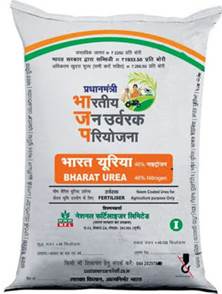Description

Disclaimer: Copyright infringement not intended.
Context
- The Ministry of Chemicals and Fertilisers has decided to brand all fertilizers as "One nation, one fertilizer" under the name Pradhanmantri Bhartiya Januvarak Pariyojna (PMBJP).
- The government said a logo using PMBJP fertilizer scheme will be placed on the side of the fertilizer packs.
Details
- Under the new “One Nation One Fertiliser” scheme, companies are allowed to display their name, brand, logo and other relevant product information only on one-third space of their bags. . On the remaining two-thirds space, the “Bharat” brand and Pradhanmantri Bharatiya Jan Urvarak Pariyojana logo will have to be shown.
- The single brand name for UREA, DAP, MOP and NPK etc. would be BHARAT UREA, BHARAT DAP, BHARAT MOP and BHARAT NPK etc. respectively for all Fertiliser Companies, State Trading Entities (STEs) and Fertiliser Marketing Entities (FMEs).
- As mentioned earlier, the logo indicating Fertiliser subsidy scheme namely Pradhanmantri Bhartiya Janurvarak Pariyojna will be used on fertiliser bags.

Rationale behind the Scheme
All key roles played by the Government
- The maximum retail price of urea is currently fixed by the government, which compensates companies for the higher cost of manufacturing or imports incurred by them. The MRPs of non-urea fertilisers are, on paper, decontrolled. But companies cannot avail of subsidy if they sell at MRPs higher than that informally indicated by the government. Simply put, there are some 26 fertilizers (inclusive of urea), on which government bears subsidy and also effectively decides the MRPs.
- Apart from subsidising and deciding at what price companies can sell, the government also decides where they can sell. This is done through the Fertiliser (Movement) Control Order, 1973. Under this, the department of fertilizers draws an agreed monthly supply plan on all subsidized fertilizers in consultation with manufacturers and importers. This supply plan is issued before the 25th of each month for the following month, with the department also regularly monitoring movement to ensure fertiliser availability as per requirement, including remote areas.
- When the government is spending vast sums of money on fertiliser subsidy (the bill is likely to cross Rs 200,000 crore in 2022-23), plus deciding where and at what price companies can sell, it would obviously want to take credit and send that message to farmers.
Drawbacks of the scheme
- It will disincentives fertiliser companies from undertaking marketing and brand promotion activities. They will now be reduced to contract manufacturers and importers for the government. Any company’s strength ultimately is its brands and farmer trust built over decades.
- The move could harm the fertiliser companies as brands apart from being product differentiator also helps in building an image of the firm while going into the farmers’ fields. Fertiliser companies do a lot of extension activities such as field-level demonstrations, crop surveys etc, where their brands are displayed prominently and it also helps in reaching out to the farmers. All this will now stop.
- Fertiliser companies said this will destroy their own branding and lead to an unnecessary uniformity in the market.
- Currently, in case of any bag or batch of fertilisers not meeting the required standards, the blame is put on the company. But now, that may be passed on fully to the government. Politically, the scheme might well boomerang rather than benefit the ruling party.
https://indianexpress.com/article/explained/everyday-explainers/one-nation-one-fertiliser-scheme-explained-risks-challenges-drawbacks-8111071/












